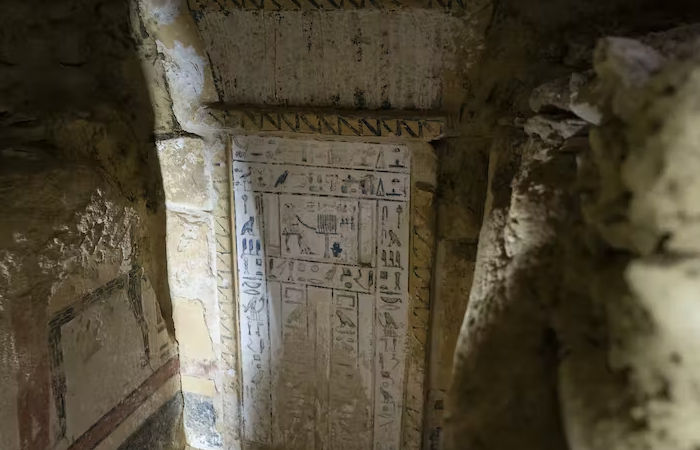Archaeologists Have Discovered A Mummy Wrapped In Gold – Here’s What It Tells Us About Ancient Egyptian Beliefs
AncientPages.com - In January 2023, a group of archaeologists excavating tombs in the ancient necropolis of Saqqara, near Cairo, discovered the mummified remains of a man named Hekashepes, who lived circa 2300BC. Found inside a limestone sarcophagus in a burial shaft, the body and its wrappings are unusually well preserved for the period.
In the 5th century BC, the Greek historian Herodotus of Halicarnassus described the elaborate way Egyptians preserved their dead. The brain was removed through the nostrils with a hook, while the inner organs were removed through a cut in the abdomen.
A general view inside one of the tombs recently discovered in Saqqara, including that of Hekashepes. Credit: Mohamed Hossam Eldin
The cut was then stitched up and the body rinsed with wine and spices. The body was left to dry in a natron solution (a substance harvested from dry lake beds and used to absorb moisture) for up to 70 days. After this period, it was carefully wrapped in linen bandages and finally laid to rest inside a coffin.
By the time Herodotus wrote this, Egyptians had been practising mummification for more than two millennia, gradually perfecting the technique through experimentation.
The pre-dynastic mummies of the fourth millennium BC were so well preserved by the dry desert sands – without human intervention – that their tattoos are still visible. The earliest attempts to replicate this outcome by artificial means were less effective so Hekashepes represents an early example of successful preservation.
Why did ancient Egyptians mummify their dead?
Egyptians had long observed that bodies interred in graves without direct contact with the drying sands tended to decompose and sought to prevent this for religious reasons.
Without a physical body to which it could return, they believed the Ka (soul essence) could not partake in food offerings brought to the cemetery and was instead left to roam the world of the living as a harmful spirit.
Mummification techniques were developed in order to preserve the body for the Ka. The earliest methods, which emerged no later than the time of state unification circa 3100BC, involved wrapping the body with resin-soaked linen bandages. However, as the intestines were left in place, the body eventually decomposed.
The lack of preserved human remains from this early period means that archaeologists have limited data on demographics, population health, life expectancy and diet. For this reason, the discovery of Hekashepes’ remains is highly significant.
Scientific examination of the body will provide important insight into the mummification techniques used. Scientific analysis of the skeleton and teeth might also shed light on where Hekashepes grew up, what kind of food he ate, his health, his age and the cause of his death.
How was Hekashepes preserved?
Hekashepes’ arms and legs had been individually wrapped to give the body a life-like appearance, and the head was painted with eyes, a mouth and dark hair. More striking, however, are the gold leaves that had been carefully applied to give the illusion of golden skin.
According to Egyptian beliefs, gold was the colour of the gods, and gilding the bodies of the dead expressed the idea that they acquired divine qualities in the afterlife.
As such, Hekashepes’ loved ones could take comfort in knowing that he would be reborn and rejuvenated in the afterlife, enjoying his favourite food and drink with the gods for all eternity.
What does the discovery teach us?
The archaeologists who uncovered Hekashepes’ sarcophagus also discovered, in a nearby tomb, a group of well-preserved limestone statues depicting men, women and children. These images, which only the wealthy could afford, were made to accompany burials as “reserve bodies” for the Ka to inhabit.
The beautiful statues, on which paint is still visible, depict men with athletic bodies and reddish-brown skin. The women are curvy and pale. Both sexes are depicted with luscious dark hair.
The images reflect gender roles in which men took on active roles in the public sphere, while women stayed indoors and looked after the home. Some of the statues depict women engaged in domestic tasks like grinding grain and baking bread, demonstrating the importance placed on women’s labour in the household.
The statues of married couples depict the husbands and wives affectionately linking arms. Some are shown with their children standing or kneeling by their feet.
The images of married couples and families emphasise the importance of the family as the basic social unit in ancient Egyptian society. Kinship ties were maintained in death and the living had an obligation to provide food offerings to sustain their relatives in the afterlife.
Although it is easy to get the impression that the ancient Egyptians were obsessed with death, the care with which they treated their dead reveals a love for life and a sincere hope of continued existence after death.
The discovery of Hekashepes’ body gives us hope that more well-preserved human remains from the period will come to light and increase our understanding of life in the age of the pyramids.
Written by Maiken Mosleth King, Lecturer in Ancient History, University of Bristol
Provided by The Conversation
This article is republished from The Conversation under a Creative Commons license. Read the original article.
More From Ancient Pages
-
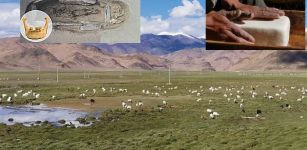 Research Reveals A 3,500-Year History Of Dairy Consumption On The Tibetan Plateau
Archaeology | Apr 17, 2023
Research Reveals A 3,500-Year History Of Dairy Consumption On The Tibetan Plateau
Archaeology | Apr 17, 2023 -
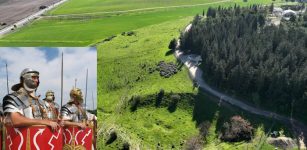 First Roman Military Amphitheater Unearthed Near Megiddo
Archaeology | Jun 1, 2022
First Roman Military Amphitheater Unearthed Near Megiddo
Archaeology | Jun 1, 2022 -
 Killer-Of-Enemies – Mysterious Non-Human Teacher And Hero Of The Apache Indians
Featured Stories | Nov 16, 2020
Killer-Of-Enemies – Mysterious Non-Human Teacher And Hero Of The Apache Indians
Featured Stories | Nov 16, 2020 -
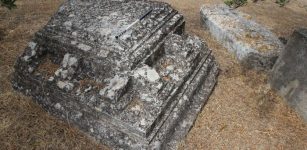 LIDAR Disovers 2,000-Year-Old Roman Temple Under Church In Danilo, Croatia
Archaeology | Dec 6, 2022
LIDAR Disovers 2,000-Year-Old Roman Temple Under Church In Danilo, Croatia
Archaeology | Dec 6, 2022 -
 Oldest Canoe Ever Discovered In Maine – It Dates To 1280-1380 A.D
Archaeology | Jun 13, 2019
Oldest Canoe Ever Discovered In Maine – It Dates To 1280-1380 A.D
Archaeology | Jun 13, 2019 -
 New Path For Early Human Migrations Contradicts A Single ‘Out Of Africa’ Theory
Evolution | Oct 5, 2023
New Path For Early Human Migrations Contradicts A Single ‘Out Of Africa’ Theory
Evolution | Oct 5, 2023 -
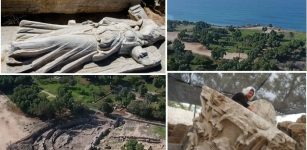 Huge 2,000-Year-Old Roman Basilica Discovered In Israel May Have Been Built By Herod The Great
Archaeology | Jul 29, 2021
Huge 2,000-Year-Old Roman Basilica Discovered In Israel May Have Been Built By Herod The Great
Archaeology | Jul 29, 2021 -
 Giant Egyptian Pyramids Hidden Beneath The Sand Dismissed By Egyptologists Without Investigation!
Archaeology | Jun 29, 2020
Giant Egyptian Pyramids Hidden Beneath The Sand Dismissed By Egyptologists Without Investigation!
Archaeology | Jun 29, 2020 -
 Likho (Licho): Puzzling And Persistent Demon Of Mischief In Slavic Mythology
Featured Stories | Dec 18, 2016
Likho (Licho): Puzzling And Persistent Demon Of Mischief In Slavic Mythology
Featured Stories | Dec 18, 2016 -
 Burnt Food Remains In Neolithic Cooking Pot Sheds Light On 5,000-Year-Old Food Preparation
Archaeology | Jan 23, 2024
Burnt Food Remains In Neolithic Cooking Pot Sheds Light On 5,000-Year-Old Food Preparation
Archaeology | Jan 23, 2024 -
 On This Day In History: ENIGMA The Secret Code Used By Germans Was Finally Broken- On July 9, 1941
News | Jul 9, 2016
On This Day In History: ENIGMA The Secret Code Used By Germans Was Finally Broken- On July 9, 1941
News | Jul 9, 2016 -
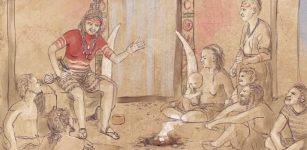 Mystery Of The Copper Age ‘Ivory Lady’ Solved
Archaeology | Jul 6, 2023
Mystery Of The Copper Age ‘Ivory Lady’ Solved
Archaeology | Jul 6, 2023 -
 Ancient Greeks Had Great Understanding Of Weather And Climate
Civilizations | Sep 7, 2015
Ancient Greeks Had Great Understanding Of Weather And Climate
Civilizations | Sep 7, 2015 -
 Unexplained Phenomena Witnessed Around Mysterious Ancient Stone Structures In New York – Can A Sacred Native American Mountain Offer Clues?
Featured Stories | Nov 3, 2024
Unexplained Phenomena Witnessed Around Mysterious Ancient Stone Structures In New York – Can A Sacred Native American Mountain Offer Clues?
Featured Stories | Nov 3, 2024 -
 Rasputin – Controversial Mystic With Healing Powers – An Evil Or Misunderstood Man?
Featured Stories | Aug 4, 2018
Rasputin – Controversial Mystic With Healing Powers – An Evil Or Misunderstood Man?
Featured Stories | Aug 4, 2018 -
 Climate Played A Crucial Role In Human Migration From Africa – New Study
Archaeology | Dec 8, 2023
Climate Played A Crucial Role In Human Migration From Africa – New Study
Archaeology | Dec 8, 2023 -
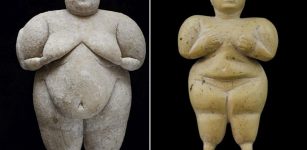 Figurines Unearthed At 9,000-Year-Old Çatalhöyük Site Symbolize Elderly Women, Not Goddess Cybele
Archaeology | Mar 1, 2017
Figurines Unearthed At 9,000-Year-Old Çatalhöyük Site Symbolize Elderly Women, Not Goddess Cybele
Archaeology | Mar 1, 2017 -
 200-Year-Old Message In A Bottle Written By Archaeologist Unearthed In France
Archaeology | Sep 30, 2024
200-Year-Old Message In A Bottle Written By Archaeologist Unearthed In France
Archaeology | Sep 30, 2024 -
 Enchanted Ancient Egyptian Amulet Seal Discovered In Türkiye’s Amasra
Archaeology | Nov 15, 2022
Enchanted Ancient Egyptian Amulet Seal Discovered In Türkiye’s Amasra
Archaeology | Nov 15, 2022 -
 Discovery Of Chromosomes Offers Evidence Of Ancient Humans Living In South America Over 18,000 Years Ago
Archaeology | Aug 21, 2022
Discovery Of Chromosomes Offers Evidence Of Ancient Humans Living In South America Over 18,000 Years Ago
Archaeology | Aug 21, 2022

